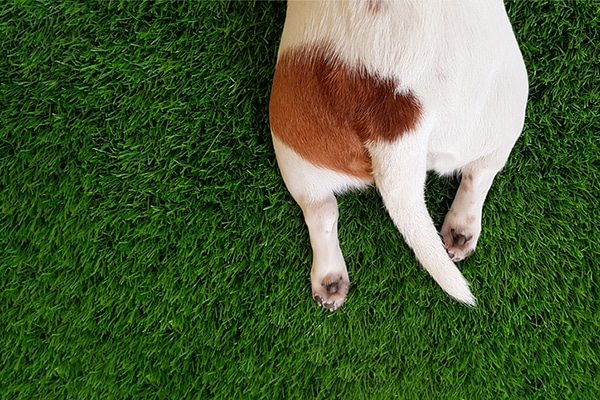When it comes to dog body language signs, sometimes happiness isn’t what you think it is. Interpreting dogs is fraught with misunderstandings because we aren’t reading all the body parts at once, nor are we paying attention to what’s happening at that moment. We know that dogs have emotions and the way that they express them is with their first language — body language. So, it’s critical that we learn the subtle nuances of dog body language signs so that we can keep pups safe in our human-dominated world.
Humans have come so far in spoken language, yet we have lost much of our ability to read subtle signs offered by each other and even more so with signs offered by our dogs.
Does a dog who’s grinning mean a dog who’s happy? How about the dog with a very funny clown mouth, or a dog who’s wagging her tail? Let’s take a closer look at some commonly misunderstood, and therefore misinterpreted, dog body language signs.
The 3 Misunderstood Dog Body Language Signs
1. Dog Body Language Sign: Look Away
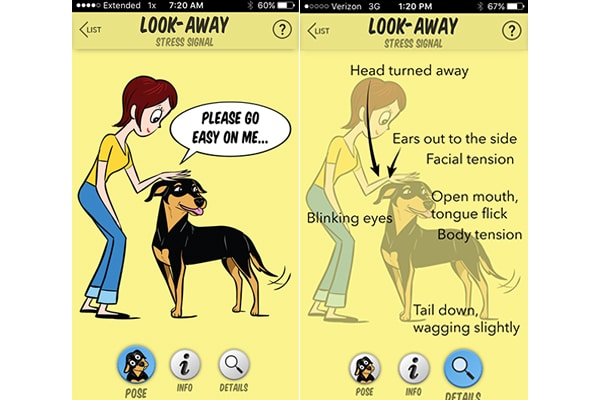
In the illustration above, ‘Diamond’, the star of the Dog Decoder smartphone app, is being greeted nicely by a woman. But is he happy? No! This image confuses most people because he’s not showing obvious signs of discomfort. But, he is indeed uncomfortable with this greeting. The subtle and often the first behavior or body language sign a dog will offer is the look away. If you look at the body parts talking along with the context of this scenario, you’ll see that all of them are expressing discomfort.
2. Dog Body Language Sign: Clown Mouth or Grinning
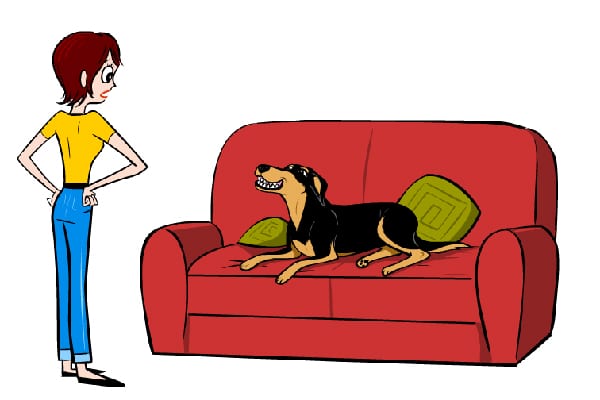
Grinning is a tricky dog body language sign because many puppies and dogs do this when they are fearful. Oftentimes we, as guardians, get a kick out of this and our laughter captures it, turning it into something our dogs do on cue. This sometimes helps the puppy through whatever was making him anxious, but if it’s not managed properly by understanding that the pup is struggling with whatever is going on, it can turn sour, causing more anxiety and fear in the puppy.
3. Dog Body Language Sign: Tail Wagging
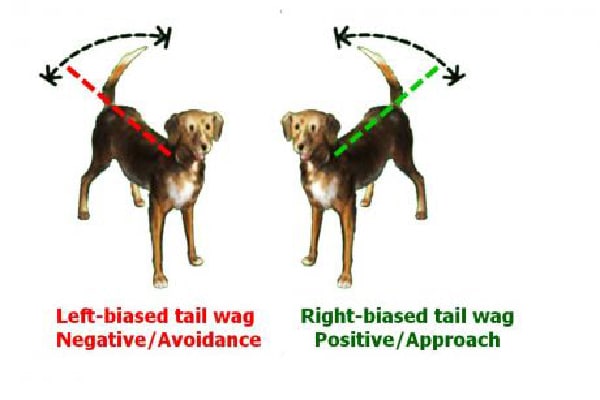
It’s common to think that tail wagging means a dog is happy, but this isn’t always the truth. Dogs wag their tails when they are afraid, happy, anxious, alert and when they feel threatened, which is a sign of aggression. The speed, height and direction with which the tail is wagging all tell different stories about how dogs are feeling. There’s even a study showing that a right-wagging tail means the dog is relaxed, while a left-wagging tail means the dog is feeling stressed. Dogs are very good at reading each other and they indeed do notice the side the tail is wagging on, while we may not see it and then wonder why a fight happened.
Happy dog tails usually wag horizontally along with a loose and wiggly body. Stressed dogs may show high tails wagging super-fast along with a tense body. Some dogs with curly tails, like Akitas, Pugs and Basenjis are harder to read. That’s why it’s important to pay attention to the other body parts talking, such as ears, and a loose and wiggly or tense body.
A Final Word on Dog Body Language Signs
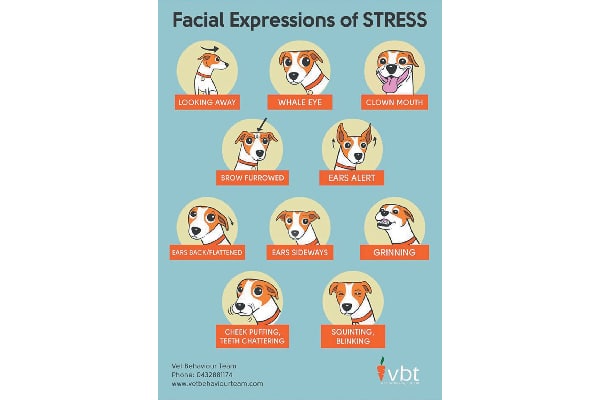
Always pay attention to what dogs are saying through body language so that we can help them when they are feeling anxious. Dog body language signs are your dog’s first language and if we don’t listen, we might set our dogs up to fail. Stop, access the situation, remove anything that may be causing anxiety and proceed only when the dog isn’t showing any signs of stress.
Learning how to read dogs will go a long way to properly understanding how dogs are feeling. When we understand how our dogs are feeling, we are better able to help them when they are feeling stressed and stop a potential bite from occurring.
Tell us: Have you ever misinterpreted any dog body language signs? What dog body language signs would you like us to cover?
Plus, learn how to read your dog’s facial expressions >>
Read more about dog body language on Dogster.com:
- 5 Keys to Understanding Dog Body Language
- Whale Eyes in Dogs — What It Means When the Whites of Your Dog’s Eyes Show
- What Does It Mean When Your Dog Lifts a Paw?
Award-winning writer Jill Breitner has been training dogs since 1978. Her passion lies in teaching people about dog body language. Jill created the Dog Decoder app as a way to enhance the human-dog bond by understanding them better. She also does online dog training worldwide. You’ll find her at play near the ocean or on the trails. Follow her at dogdecoder.com, facebook.com/dogdecoder and on Twitter @shewhispers.
Featured Image Credit: ulkas | Thinkstock.

